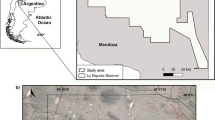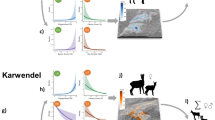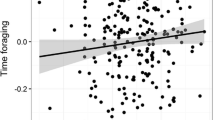Abstract
Increased resource availability should favor higher animal density. It may also affect sex ratio, the male condition, and mating competition over access to females, although the direction of these variables is not straightforward to predict. Using a non-experimental approach, we carried out preliminary research using the territorial American rubyspot (Hetaerina americana) by comparing two spatially separated populations and the same population in two different seasons (each comparison with varying population densities). We first compared the sex ratio by counting males (using two categories, territorial and non-territorial) and females; relative foraging time (as an indicator of how much feeding resources each site provides); wing spot size (a sexual ornament), body size and immune melanization response (these two variables were used to assess male condition); and fighting time and contest number (to assess competition). For the seasonal comparison we used a third population in which we only compared male spot size and two indicators of condition and immune response, phenoloxidase (PO) and nitric oxide (NO) activity. The high-density population had higher values of non-territorial males (but similar sex ratio), relative foraging time, contest time and number, wing spot (but similar body size) and melanization response than the low-density population. According to season, at high density, males had higher values of wing spots, PO, and NO. Our results suggest that in a population where animals have more dietary resources, males reach a better condition despite the competition being more intense.






Similar content being viewed by others
References
Andersson M (1994) Sexual selection. Princeton University Press, Princeton, NJ
Andersson M, Simmons LW (2006) Sexual selection and mate choice. Trends Ecol Evol 21:296–302
Bogdan C (2001) Nitric oxide and the immune response. Nat Immunol 2:907–916
Cerenius L, Söderhäll K (2004) The prophenoloxidase-activating system in invertebrates. Immunol Rev 198:116–126
Choquenot D (1991) Density-dependent growth, body condition, and demography in feral donkeys: testing the food hypothesis. Ecology 72:805–813
Claes A, Göran N (1983) Reproductive tactics in an island population of Adders, Vipera verus (L.), with a fluctuating food resource. Amphib Reptil 4:63–79
Contreras-Garduño J, Canales-Lazcano J, Córdoba-Aguilar A (2006) Wing pigmentation, immune ability and fat reserves in males of the rubyspot damselfly Hetaerina americana. J Ethol 24:165–173
Contreras-Garduño J, Buzatto BA, Abundis L, Nájera-Cordero K, Córdoba-Aguilar A (2007a) Wing colour properties do not reflect male condition in the American rubyspot (Hetaerina americana). Ethology 113:944–952
Contreras-Garduño J, Lanz Mendoza H, Córdoba-Aguilar A (2007b) The expression of a sexually selected trait correlates with different immune response components and survival ability in males of the damselfly Hetaerina americana. J Insect Physiol 53:612–621
Contreras-Garduño J, Buzatto B, Serrano-Meneses MA, Nájera-Cordero K, Cordoba-Aguilar A (2008) The size of the red wing spot of the American rubyspot as a heightened condition-dependent ornament. Behav Ecol (in press)
Corbet PS (1999) Dragonflies. Behavior and ecology of Odonata. Harley Books, Colchester
Córdoba-Aguilar A, Cordero Rivera A (2005) Evolution and ecology of Calopterygidae (Zygoptera: Odonata): status of knowledge and research perspectives. Neot Entomol 34:861–879
Córdoba-Aguilar A, Contreras-Garduño J, Peralta-Vázquez H, Luna-González A, Campa-Córdova AI, Ascencio F (2006) Sexual comparisons in immune ability, parasite intensity and survival in two damselfly species. J Insect Physiol 52:861–869
Córdoba-Aguilar A, Contreras-Garduño J (2006) Differences in immune ability in forest habitats of varying quality: dragonflies as study models. In: Cordero A (ed) Forests and dragonflies. Pensoft Publishers, Sofia, pp 269–278
Cotton S, Fowler K, Pomiankowski A (2004) Do sexual ornaments demonstrate heightened condition-dependent expression as predicted by the handicap hypothesis? Proc R Soc Lond B 271:771–783
Davies SA (2000) Nitric oxide signalling in insects. Insect Biochem Mol Biol 30:1123–1138
Eason PK, Switzer PV (2004) The costs of neighbours for a territorial dragonfly, Perithemis tenera. Ethology 110:37–49
Foley E, O’Farrell PH (2003) Nitric oxide contributes to induction of innate immune response to Gram-negative bacteria in Drosophila. Gen Dev 17:115–125
Gillespie JP, Kanost MR, Trenzeck T (1997) Biological mediators of insect immunity. Annu Rev Entomol 42:611–643
Grether GF (1996a) Sexual selection and survival selection on wing coloration and body size in the rubyspot damselfly Hetaerina americana. Evolution 50:1939–1948
Grether GF (1996b) Intrasexual competition alone favors a sexually dimorphic ornament in the rubyspot damselfly Hetaerina americana. Evolution 50:1949–1957
Grether GF, Grey RM (1996) Novel cost of a sexually selected trait in the rubyspot damselfly Hetaerina americana: conspicuousness to prey. Behav Ecol 7:465–473
Herrera-Ortíz A, Lanz-Mendoza H, Martínez-Bernetche J, Hernández-Martínez S, Villareal-Treviño C, Aguilar-Marcelino L, Rodríguez MH (2004) Plasmodium berghei ookinetes induce nitric oxide production in Anopheles pseudopunctipennis midguts cultured in vitro. Insect Biochem Mol Biol 34:8
Hogstedt G (1981) Effect of additional food on reproductive success in the magpie (Pica pica). J Anim Ecol 50:219–229
Iwasa Y, Pomiankowski A, Nee S (1991) The evolution of costly mate preference. II. The handicap principle. Evolution 45:1431–1442
Iwasa Y, Pomiankowski A (1994) The evolution of male preference for multiple handicaps. Evolution 48:853–867
Kokko H, Sutherland WJ (1998) Optimal floating and queuing strategies: consequences for density dependence and habitat loss. Am Nat 152:354–366
Kokko H, Sutherland WJ, Johnstone R (2001) The logic of territory choice: implications for conservation and source-sink dynamics. Am Nat 157:459–463
Kotiaho JS (2001) Cost of sexual traits: a mismatch between theoretical considerations and empirical evidence. Biol Rev 76:365–376
López-Sepulcre A, Kokko H (2005) Territorial defense, territory size, and population regulation. Am Nat 166:317–329
Leclerc V, Reichhart JM (2004) The immune response of Drosophila melanogaster. Immunol Rev 198:59–71
Luckhart S, Vodovotz Y, Cui L, Rosenberg R (1998) The mosquito Anopheles stephensi limits malaria parasite development with inducible synthesis of nitric oxide. Proc Natl Acad Sci USA 95:5700–5705
Marden JH, Cobb JR (2004) Territorial and mating success of dragonflies that vary in muscle power output and presence of gregarine gut parasites. Anim Behav 68:857–865
Metcalfe NB, Monaghan P (2001) Compensation for a bad start: grow now, pay later? Trends Ecol Evol 16:254–260
Moore FR, Young W (1991) Evidence of food-based competition among passerine migrants during stopovers. Behav Ecol Sociobiol 28:85–90
Müller U (1997) The nitric oxide system in insects. Prog Neurobiol 51:363–381
Nappi AJ, Christensen BM (2005) Melanogenesis and immune-associated cytotoxic reactions: applications to insect innate immunity. Insect Biochem Mol Biol 35:443–459
Nappi AJ, Vass E, Frey F, Carton Y (2000) Nitric oxide involvement in Drosophila immunity. Nitric Oxide 4:423–430
Narayanan K (2004) Insect defence: its impact on microbial control of insect pests. Curr Sci 86:800–814
Penn I, Weissing FJ (2000) Optimal floating and queuing strategies: the logic of territory choice. Am Nat 155:512–526
Raihani G, Serrano-Meneses MA, Córdoba-Aguilar A (2008) Male mating tactics in the American rubyspot damselfly: territoriality, nonterritoriality and switching behaviour. Anim Behav (in press)
Rantala MJ, Koskimäki J, Taskinen J, Tynkkynen K, Suhonen J (2000) Immunocompetence, developmental stability and wingspot size in the damselfly Calopteryx splendens L. Proc R Soc Lond B 267:2453–2457
Regulski M, Stasiv Y, Tully T, Enikolopov G (2004) Essential function of nitric oxide synthase in Drosophila. Curr Biol 14:R881–R882
Rivero A (2006) Nitric oxide: an antiparasitic molecule of invertebrates. Trends Parasitol 22:352–352
Serrano-Meneses MA, Córdoba-Aguilar A, Méndez V, Layen SJ, Székely T (2007) Sexual size dimorphism in the American rubyspot: male body size predicts male competition and mating success. Anim Behav 136:1365–1377
Shochat E, Abramsky Z, Pinshow B, Whitehouse MEA (2002) Density-dependent habitat selection in migratory passerines during stopovers: what causes the deviation from IFD? Evol Ecol 16:469–488
Siva-Jothy MT (2000) A mechanistic link between parasite resistance and expression of a sexually selected trait in a damselfly. Proc R Soc Lond B 267:2523–2527
Skogland T (1985) The effects of density-dependent resource limitation on the demography of wild reindeer. J Anim Ecol 54:359–374
Svensson EI, Eroukhmanoff F, Friberg M (2006) Effects of natural and sexual selection on adaptive population divergence and premating isolation in a damselfly. Evolution 60:1242–1253
Söderhäll K, Häll L (1984) Lipopolysaccharide-induced activation of prophenoloxidase activity system in crayfish hemocyte. Biochim Biophys Acta 109:709–713
Taylor PD, Merriam G (1995) Wing morphology of a forest damselfly is related to landscape structure. Oikos 73:43–48
Taylor PD, Merriam G (1996) Habitat fragmentation and parasitism of a forest damselfly. Land Ecol 11:181–189
Tynkkynen K, Rantala MJ, Suhonen J (2004) Intersexual aggression and character displacement in the damselfly Calopteryx splendens. J Evol Biol 17:759–767
Tzou P, De Gregorio E, Lemaitre B (2002) How Drosophila combats microbial infection: a model to study innate immunity and host-pathogen interactions. Curr Opin Microbiol 5:102–110
Zahavi A (1975) Mate selection: a selection for a handicap. J Theor Biol 53:205–214
Zahavi A, Zahavi A (1997) The handicap principle: a missing piece of Darwin’s puzzle. Oxford University Press, New York
Zar J (1999) Biostatistical analysis, 4th edn. Prentice Hall, Upper Saddle River, NJ
Acknowledgments
We would like to thank Norma E. Martínez Lendech and Iván S. Sánchez Martínez for their help in the field, the Comisariado Ejidal de Alpuyeca for the facilities to collect inside Palo Bolero. This research was funded by PAPIIT (projects IN211506 and IN230603; Universidad Nacional Autónoma de México). We also thank Raúl I. Martínez Becerril and Julie Irons for their help in the preparation of this manuscript and Gina Raihani for correcting our English grammar. When using our study animals we adhered to the Mexican ethical standards for the use of animals in research. Finally, we thank Masakado Kawata for his enriching and critical comments.
Author information
Authors and Affiliations
Corresponding author
About this article
Cite this article
Contreras-Garduño, J., Canales-Lazcano, J., Jiménez-Cortés, J.G. et al. Spatial and temporal population differences in male density and condition in the American rubyspot, Hetaerina americana (Insecta: Calopterygidae). Ecol Res 24, 21–29 (2009). https://doi.org/10.1007/s11284-008-0476-2
Received:
Accepted:
Published:
Issue Date:
DOI: https://doi.org/10.1007/s11284-008-0476-2




